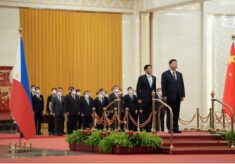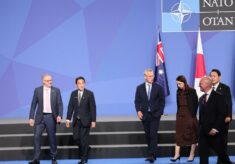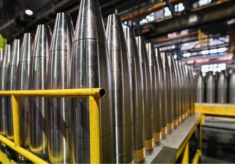Nearly 13 million displaced within Syria and almost 4 million knocking on Europe’s doors for entry. A huge humanitarian crisis with UN’s relief assistance going by fits and starts depending on the security of the convoys. A high possibility of IS radicals embedded within the refugee crowds and a surfeit of terrorist incidents within Europe, particularly France.
Two peace attempts under UN auspices by Kofi Annan and Lakhdar Brahimi having failed the US-Russian attempt appeared to have succeeded early in 2016 when for the first time Saudi Arabia and Iran were brought on common ground. Yet the travails of the Syrian situation ensured that the process is at an impasse. US has withdrawn due to unhappiness with Russia which sees things differently. It arises because of diverse war aims.
The destruction of the world’s heritage in the archeological sites all over Syria which has nurtured the the three Western religions- Christianity, Islam and Judaism- continues. Not even crocodile tears on the disappearance of human patrimony! And the surety that some of these priceless artifacts will be on sale with antique dealers in New York.
Military situation
A complicated military situation on the ground becoming even more knotted with many players with multiple aims. But this is not all: the military, political and religious situation in Aleppo is linked with the military actions in Mosul, and lower down, in San’aa.
The situation in Syria is marked by severe battles raging around east Aleppo. Four years of internecine warfare has seen a multiplicity of combatants and targets in cascading concentric circles.
At its inner-most core is the Syrian Army and para-military forces combating ALL the radical Islamic militant groups, Sunni in religious orientation, bent on evicting Bashar Assad from power. To the extent needed these forces also battle the Islamic State forces which pursue a larger target of establishing an Islamic Caliphate in the Middle East starting with Iraq and Syria.
The next circle includes forces ranged on either side comprising Russian ground and air forces and Iranian ground militias supporting the Assad regime; and Saudi, Qatari and Turkish forces supporting either by defence material or specialist cadres, according to their predilection, various Sunni militant groups fighting the Assad regime and engaging the IS as needed but not necessarily to eliminate them.
The next circle is marked by the Kurdish peshmarga both in Syria and Iraq mainly focused on liberating their cities and villages in the area bordered by Mosul in Iraq and Deir ez Zor in Syria while keeping a weather eye open for attacks by the Turkish Army constantly fearing peshmarga stabilization in eastern Turkey and in Erbil, the putative capital, of a Kurdish state encompassing their homelands in Iran, Iraq, Syria and Turkey.
On this militant mosaic impose the circle of Western powers- the United States with its ‘specialists’ and weaponry helping the Russians(intermittently) to battle and eliminate IS without a clear direction on the extent to which it should go in dislodging Bashar Assad fearful of direct engagement with the Russians. Neither sure of the follow-through if indeed Assad is removed (shades of Libya!). The divided aims coupled with reluctance to re-enter the Middle East theatre has hamstrung the United States from the beginning. Will the presidential election result clarify? Seems doubtful. The Americans have no workable option in Syria. France and Britain, on the other hand, do not appear to be ham-strung and have gone out to help groups keen to dislodge Assad. To what end no one knows.
Even more, the US is taking sides with religiously-oriented forces but that too inconsistently: In Yemen it fights with the Saudi(Sunni), in Iraq with the Army(Shia) and in Syria in an indeterminate fashion with both sides.
In Mosul, the Iraqi Army (mainly Shia) supported by the Kurdish (mostly Sunni) peshmarga, Iranian forces( Shia) fighting to evict IS from Iraq’s second largest city which used to be majority Kurdish before the late lamented Saddam Hussein decided to change the population balance. The US elements here give expert electronic help and military assistance to the Iraqi Army.
In Yemen the Saudi Air force and Army, under the able Crown Prince, are battling the Houthis(Shia) from gaining power in Sana’a unmindful of the loss of civilian life and destruction of hospitals. And the US has now pitched in to help the Saudi(Sunni).
Is a solution possible?
It will require the powers in the region and others involved to work on TWO fronts simultaneously. Since the beginning of this internecine conflict, the factor of religion has never once been broached. This even though Islam lies behind the Syrian war. The invasion of Iraq in 2003 opened the religious Pandora’s box on the Middle East. The genie cannot be put back in the bottle. Here is where matters rest presently:
-
The military war reflects the overt manifestation of an ideological conflict within Islam- between the Sunni and the Shia. Hence to expect the two sides to make common cause on the Syrian war may be too much to expect;
-
A proxy war rages in West Asia between Saudi Arabia and Iran, leading the two sides of Islam’s sectarian divide, fueled by Iran’s growing assertion of its crucial role in the region; and a belief on the part of the Sunnis that for accounting only ten percent of all Muslims in the world the Shia have acquired far too much power;
-
The Western powers led by US, Europe and NATO might achieve some success in military operations against IS but will be incapable of dealing with the religious issue.
If efforts at peace have to succeed the US-Russian attempt will have to be revived by looking at the issue in totality. It will have two simultaneous threads:
-
To make all efforts to call a cease-fire by ALL parties across ALL theatres- Aleppo, Mosul and Sana’a. Once that is established immediate provision by UN of humanitarian assistance to those affected with the aim of stopping further movement of people outside national boundaries. The third step will be to revive the political process in Syria; and a second track in Yemen.
-
The second simultaneous thread will call a conference of ALL Islamic countries, not only those involved in the Middle East conflict, including important Islamic states like Nigeria, Pakistan, Bangladesh, and other states with large Muslim populations, to resolve the sectarian problem within Islam. This issue will not go away but by wisdom and participation of all important countries. Its incidence needs to be minimized enough to buttress a political settlement in Syria, Yemen and Iraq.
It is an issue for the Islamic world to resolve in which others like the Western powers can only assist. Failing a simultaneous effort, the current situation will go on endlessly with loss of NATO and Western assets, funds and soldiers to no avail. For in the end the Islamic State is an extreme and retrograde manifestation of Islam. Even in the unlikely event that IS can be physically destroyed by the force of Western arms the idea will not die. To remember: The Muslim Brotherhood revived in 2011 after being virtually destroyed in the 1970’s. And all religions have their extremist fringes, that is what they must remain.
Rajendra Abhyankar – former Indian diplomat, was Indian Ambassador in Syria. He currently teaches at the School of Public and Environmental Affairs, Indiana University, Bloomington





















